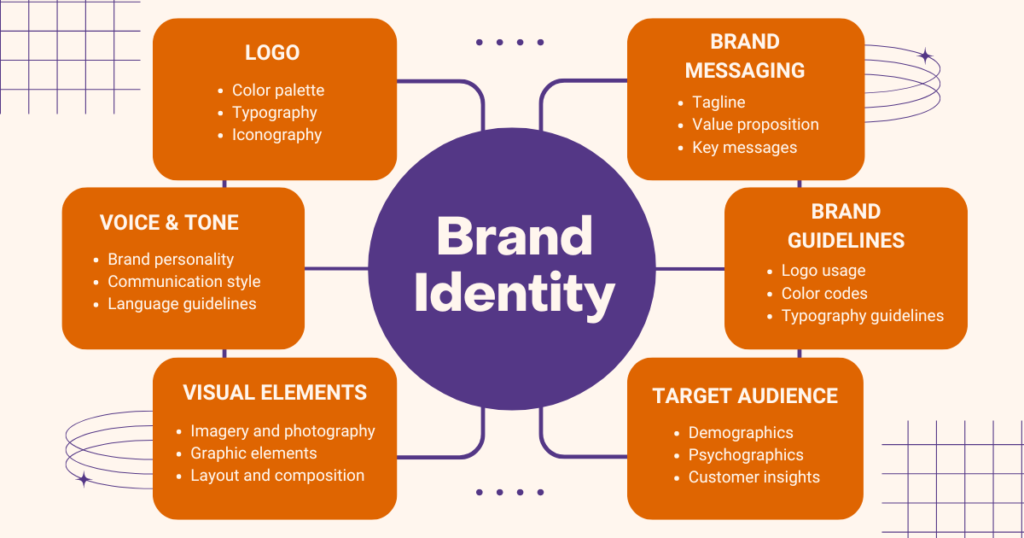What is Brand Identity and How to Build a Strong One
Brand identity plays a crucial role in shaping your overall brand strategy. It encompasses the unique elements that define how your brand looks, feels, and behaves in the marketplace. These elements range from the brand’s name, history, and values, to its personality and visual components such as logos, colors, and typography. Together, they create a cohesive image that differentiates your brand from competitors and resonates with your target audience.
Imagine brand identity like a person’s identity. Just as a person has a name, personality, values, and a story that make them who they are, a brand’s identity functions in the same way. It’s the combination of attributes that shape how people perceive, connect, and engage with your brand. A strong, well-defined brand identity helps build trust, evokes emotions, and creates lasting impressions in the minds of consumers.
Beyond just visuals, brand identity also influences how your brand communicates, the tone of voice it uses, and the overall customer experience it provides. By having a consistent and memorable identity, your brand becomes more relatable and recognizable, fostering loyalty and long-term success.
Table of Contents
Why Brand Identity Matters

Brand identity is essential for making your brand stand out, be memorable, and build lasting connections with your customers. It goes beyond the product you offer—it’s about creating a meaningful experience that resonates with your audience. A strong brand identity has the power to turn first-time buyers into loyal fans by building a deeper emotional connection.
In today’s world, people don’t just buy products—they also look for brands with stories and values they can relate to. A strong brand identity lets you share your story, helping build trust and loyalty with your audience. When people feel connected to your values and mission, they are more likely to stick with your brand and recommend it to others. This is how brand identity helps grow lasting relationships with your customers.
Benefits of a Strong Brand Identity
- Uniqueness means understanding what sets your brand apart from others, what makes it special or different.
- Emotional connection is about creating a strong bond or relationship with your audience, making them feel connected to your brand on a personal level.
- Consistency is about always being clear and consistent in how you communicate your brand’s message, ensuring that it remains reliable and recognizable.
- Clarity involves knowing which aspects of your brand should remain consistent and which can be flexible or adaptable, helping you maintain a clear and focused brand identity.
Brand identity is how you want your audience to perceive your brand—it’s the message, values, and personality you consciously project. It differs from brand image, which is the actual impression people form based on their experiences with your brand. While brand identity is something you shape, brand image is how others see you.
Some brands fall into the trap of copying competitors or chasing short-term trends, which can dilute their uniqueness. When a brand tries to be everything to everyone, it often ends up looking generic and loses its emotional connection with its audience. A strong brand identity, on the other hand, is rooted in authenticity. It reflects your brand’s true values and differentiates you in a crowded market. By staying true to who you are, you build a more loyal and engaged audience that resonates with your message.
Importance of Authenticity
A strong, authentic brand identity is essential for building meaningful connections with your audience. When your brand clearly defines who it is and communicates that consistently, it creates trust and loyalty. People are drawn to brands that stand for something and feel genuine. This connection goes beyond just offering products or services—it creates an emotional bond that makes customers feel understood and valued.
Brands that truly know their purpose and consistently express their unique identity are more likely to thrive over time. They stand out in a crowded market because their messaging is clear and relatable. Instead of blending in with competitors, these brands create lasting impressions and are more likely to attract repeat customers, ultimately ensuring long-term success.

Key Parts of a Strong Brand Identity
Brand Story
Your brand story is a unique and engaging narrative about how your brand began and what it represents. It highlights your journey, values, and mission, helping to create a personal connection with your audience.
A good brand story shows the passion and purpose behind your business, making it relatable and memorable. It explains why your brand exists and what makes it special. By sharing this story, you can build trust and loyalty, making customers feel more connected to your brand.
Brand Name
Your brand’s name is usually the first thing people notice. It should be memorable, easy to spell, and easy to say. A strong brand name helps people remember your brand and evokes a certain feeling or emotion. It sets the tone for your brand and can make a lasting impression.
Choosing the right name is important because it reflects your brand’s identity and values. It should be unique and stand out from competitors, making it easier for customers to recall and associate with positive experiences. A great brand name is a key part of building a successful brand.
Brand Personality
Giving your brand-specific character traits makes it feel more human and relatable. This helps people connect with it emotionally, fostering a stronger relationship. Your brand’s personality influences how it looks and sounds, shaping its visual style and communication.
For example, a fun and playful brand might use bright colors and casual language, while a professional and serious brand might use muted tones and formal language. By defining your brand’s personality, you create a consistent and recognizable image that resonates with your audience. This connection can lead to increased loyalty and a stronger overall brand presence.
Communication Style and Tone of Voice
Your brand’s communication style and tone of voice describe how it speaks to people. This includes the words you choose, how you express ideas, and the feelings you convey. For instance, a friendly brand might use casual language and upbeat messages, while a professional brand might use formal language and serious tones.
Your communication style sets the mood and personality of your brand, making it easier for customers to connect with and understand what you stand for. It’s like the way you talk to a friend versus how you talk in a business meeting—it reflects your brand’s identity and values.
Products or Services
People form opinions about your brand based on what you offer—your products or services. It’s important that these things match your brand’s identity and provide something special. Your products should fit with what your brand stands for and be different from what others offer. They should be unique to your brand, showing why you’re special and worth choosing. This way, when people see or use your products, they’ll connect them with your brand’s values and personality, making them more likely to remember and choose you again.
Visual Identity
Visual identity refers to how your brand appears visually, encompassing elements such as logos, colors, typography, and design style. Maintaining consistency across these visual elements helps people easily recognize and remember your brand. When your visual identity remains cohesive across different platforms and materials, it enhances brand recognition and fosters trust among your audience. This consistency reinforces your brand’s image and values, making it more memorable and distinctive in the eyes of consumers. Ultimately, a strong visual identity contributes significantly to building a positive perception of your brand and establishing a lasting connection with your customers.
Elements of Visual Identity
- Logo
- Color Palette
- Typefaces and Fonts
- Pattern and Texture
- Iconography
- Imagery and Photography Style
- Graphic Design Layouts
- Product and Packaging Design
- Print Design
Building a strong brand identity is crucial for making your brand stand out and forging genuine connections with your audience. Your brand identity is the foundation of how people perceive and interact with your business. It goes beyond just a logo or color scheme—it encompasses your values, messaging, personality, and how you communicate these elements across all touchpoints.
By carefully crafting and understanding the key components of brand identity—such as your brand’s mission, vision, voice, and visual elements—you create a distinct presence that resonates with your target audience. A well-defined identity helps you build trust, ensuring that customers not only recognize your brand but also feel aligned with what you stand for. This sense of connection fosters loyalty, making your brand memorable and unique in the minds of your customers.
In a competitive market, a strong brand identity gives you the advantage of being easily recognizable, trusted, and valued, which leads to long-term relationships with your customers and sustained business success.

What is brand identity, and why is it important?
Brand identity is the collection of elements—such as your brand’s name, logo, colors, and messaging—that shape how your audience perceives your brand. It’s important because it distinguishes your brand from competitors and creates a lasting impression on your target audience.
How does brand identity differ from brand image?
Brand identity is how you want your brand to be perceived, while brand image is how people actually perceive your brand. Brand identity is created by the business, whereas brand image is shaped by the audience’s interactions and experiences with the brand.
What are the key components of a strong brand identity?
The key components of brand identity include your brand’s logo, colors, typography, tone of voice, mission, values, and the overall personality you want to communicate. These elements should be cohesive and consistent across all platforms and interactions.
How can I create a brand identity that resonates with my audience?
To create a brand identity that resonates, you should understand your target audience’s needs, values, and preferences. Align your brand’s messaging, visuals, and tone to reflect the interests of your audience while staying true to your core values.
How does a strong brand identity impact business success?
A strong brand identity builds trust, helps your brand stand out, and creates emotional connections with customers. When people feel aligned with your brand’s values and story, they are more likely to become loyal customers, which boosts long-term business success.







